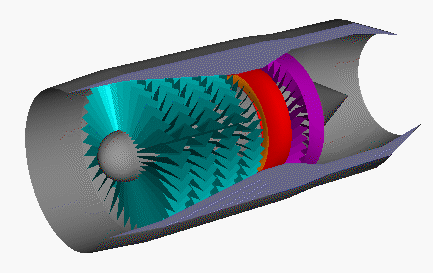
|
This page is intended for college, high school, or middle school students.
For younger students, a simpler explanation of the information on this page is
available on the
Kids Page.
|

|
Turbojet
Engine
|
Glenn
Research
Center
|








Most modern passenger and military aircraft are powered by
gas turbine
engines, which are also called
jet engines. The first and simplest
type
of gas turbine is the turbojet. How does a turbojet work?
On this slide we show a computer animation of a turbojet engine.
The
parts
of the engine are described on
other slides. Here, we are concerned with what happens to the air
that passes through the engine. Large amounts of surrounding air are
continuously brought into the engine
inlet.
(In England, they call this part the intake, which is probably a more
accurate description, since the compressor pulls air into the
engine.) We have shown here a tube-shaped inlet, like one you would
see on an airliner. But inlets come in many shapes and sizes
depending on the aircraft's mission. At the rear of the inlet, the
air enters the
compressor.
The compressor
acts like many rows of
airfoils,
with each row
producing
a small jump in pressure. A
compressor is like an electric fan. We have to supply energy to turn
the compressor. At the exit of the compressor, the air is at a much
higher pressure than free stream. In the
burner
a small amount of fuel is combined with the air and ignited. (In a
typical jet engine, 100 pounds of air/sec is combined with only 2
pounds of fuel/sec. Most of the hot exhaust has come from the
surrounding air.) Leaving the burner, the hot exhaust is passed
through the
turbine.
The turbine works
like a windmill. Instead of needing energy to turn the blades to make
the air flow, the turbine extracts energy from a flow of gas by
making the blades spin in the flow. In a jet engine we use the energy
extracted by the turbine to turn the compressor by
linking
the compressor and the turbine by the central shaft. The
turbine takes some energy out of the hot exhaust, but there is enough
energy left over to provide thrust to the jet engine by increasing
the velocity through the
nozzle.
Because
the exit velocity is greater than the free stream velocity, thrust is
created as described by the
thrust equation.
For a jet engine, the exit mass flow is nearly equal to
the free stream mass flow, since very little fuel is added to the
stream.
The
thrust equation
for a turbojet is
given on a separate slide.
Activities:



Guided Tours
-
 Jet Engines:
Jet Engines:

-
 Turbojets:
Turbojets:

-
 EngineSim - Engine Simulator:
EngineSim - Engine Simulator:

Navigation ..

- Beginner's Guide Home Page
|
